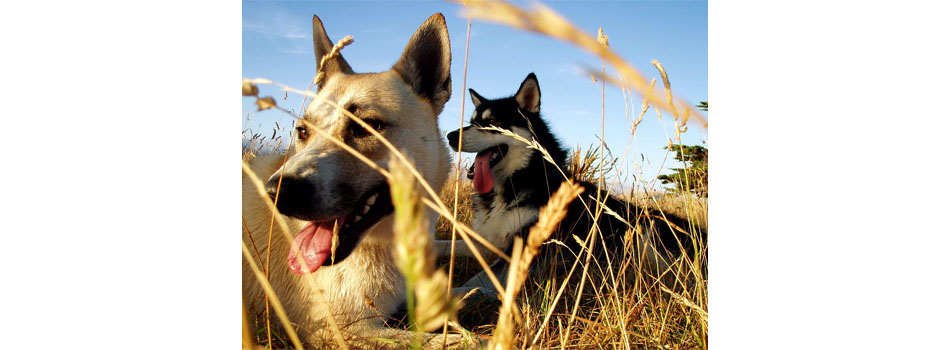Fleas are more common than most people like to believe. They terrorize our canine friends and have dog owners frequenting the vet’s office as a result. They are so quick to reproduce and love hiding in every nook and cranny in and around the house. And as soon as they come into contact with a dog, they attach themselves and feed off the dog’s blood.
There are a number of treatments for fleas, however, many contain chemicals that may be harmful to your dog or the environment. This article lists the most effective natural flea treatments for dogs so that you and your dog can enjoy a flea-free environment.
How do I tell if my dog has fleas?
Flea bites can cause irritation and excessive itching. If you notice your dog scratching more than usual, or if it has bumps on the skin and is losing a lot of hair, then there’s a chance that the dog has fleas.

Flea allergy dermatitis is the most common flea disease among pets. However, some dogs could become anemic or get tapeworms if they ingest the fleas. Bartonellosis, caused by the bacteria Bartonella, has also been linked to fleas. In this case, the dog may experience nausea, fever, an irregular heartbeat, and loss of appetite.
Where are fleas found in the US?
Fleas generally thrive in hot, humid climates, preferring temperatures between 70 – 85°F and about 70% humidity according to PetMD. That said, fleas hate direct exposure to the sun, and as you may imagine, this can come in handy when taking preventative measures against this pesky parasite.
In 2012, data from the Banfield Pet Hospital in Birmingham showed Alabama, Florida, Georgia, Louisiana, Oregon, South Carolina, Texas, and Washington as the most flea-infested states. These states can have fleas all year round, while other states like Arizona and Utah are almost free of fleas.
Natural Flea Remedies for Dogs
Now for the good news! There are several ways you can get rid of fleas without using harmful chemicals. From baths and dips to rubs and collars, there are home remedies and natural flea medicine for dogs of every temperament.
Apple Cider Vinegar
The first of the natural flea remedies for dogs that we are going to talk about is apple cider vinegar. This home remedy for fleas on dogs can be done without bathing! Fleas don’t like to be in an acidic environment. Because apple cider vinegar is acidic, it will balance the pH levels on your dog’s skin and fur, making it an unbearable environment for fleas with little to no effect on the dog.
You can use apple cider vinegar as a homemade flea spray for dogs or add it to their drinking water. To make the spray, mix six cups of apple cider vinegar with four cups of water. Add some sea salt, then pour into a spray bottle. Shake well and spray the mixture all over the dog’s coat, avoiding the eye area.
You can also add a couple of spoons of apple cider vinegar (or any vinegar of your choice in this case) to your dog’s drinking water. This will help to get rid of any ingested fleas. Remember to test this out with a small amount of vinegar first so you don’t discourage your dog from drinking water altogether.
Lemon
Another great natural flea remedy for dogs that is similar to apple cider vinegar is lemon. This highly acidic fruit is good for your dog but bad news for fleas. Lemons are readily available and easy to use and add a refreshing, citrusy scent to your dog’s coat.
Create a lemon bath by adding half a cup of freshly squeezed lemon juice to two cups of water. Then add the mixture to your normal dog bath and wash your canine friend with your normal natural pet soap or shampoo.
Alternatively, you can dip your dog’s comb in lemon juice and brush the fur with it. If your dog has little to no hair, you can use a cloth instead of a comb and wipe the dog all over, producing the same effect.
Another way to use lemon would be to boil some thin lemon slices and allow to cool overnight then spray the mixture over soft furnishings to get rid of fleas in the house. This makes a great homemade flea spray to have on hand for your dogs.

Essential Oils
Essential oils have gained popularity among humans, but did you know they are also very effective on our furry friends? There is a whole range of essential oils you can use to repel fleas, and some are potent enough to also kill fleas.
Since essential oils are so potent, they can be very dangerous when used directly or ingested. For this reason, it’s important to always use them with a carrier oil like coconut oil, avocado, or any other carrier oil of your choice. You can also dilute them with water in a glass container and shake well before use. Never add essential oils to your dog’s drinking water.
Some essential oils that are effective repellents include lavender essential oil, rose geranium essential oil, lemongrass, and rosemary essential oil. Add any of these to your dog’s natural shampoo or mix with water and carrier oil in a glass spray bottle and spray the mixture on the back of the neck. Take care not to get it in the eyes or ears.
It is important to note that you should not put this in a place where your dog can reach when licking as ingesting some of these essential oils can cause tummy upset or in some cases toxicity. Also, essential oils are very potent, so a little goes a long way.
You can also make a lavender or cedar oil collar by dipping your dog’s collar (homemade or store-bought) in water containing a few drops of the essential oil, letting it dry then putting it on the dog.
Coconut Oil and multi-purpose neem oil
Still, on the subject of oils, you can rub some coconut oil all over your dog to repel fleas and get a shiny, luxurious finish on your dog. Unlike essential oils, coconut oil is safe to ingest. So you can add some to your pet food as it acts as an antibacterial treatment when ingested.
Another great option is neem oil. Mix with water and spray it on affected areas to reduce itchiness. It’s also not toxic when ingested, but it has a nasty taste that dogs don’t like very much.
Baths and dips
These are really great for dogs that love a good splash in the water. You can use organic soaps and natural shampoos to get the dog clean. Add a few drops of essential oil to the shampoo or bath water for an extra flea-repellent boost.
You could also create a rosemary dip by soaking rosemary leaves in boiling water for a few minutes. Strain the water and dilute it with warm water until the temperature isn’t scalding. Then let your dog splash around in the treatment. It’s a fun way to treat your dog for fleas. Take care that your pup doesn’t stop to drink the dip.
Flea prevention in the environment
It’s not enough to treat your dog for fleas. If your dog has fleas, chances are your home and yard have become a breeding ground as well. Below are a few ways you can get rid of them using natural methods.
Flea trap
This is an easy way to get rid of fleas. Simply add a little bit of dishwashing soap to a bowl of warm water and lay it on the floor overnight. The mixture is especially sticky for fleas as it is highly viscous. In the morning, throw the water away and wash the bowl thoroughly.
Diatomaceous earth
Extracted from the remains of algae, this fine white powdery substance is an amazing natural flea treatment for dogs. Sprinkle an even layer on your carpet or floor, paying special attention to the places your dog frequents. Leave it there undisturbed for about 48hrs (block off the area if possible), then vacuum it up. Diatomaceous earth dehydrates flea eggs, thereby preventing another infestation. This one is a natural flea and tick treatment for dogs that you just shouldn’t skip when dealing with an infestation.
Steam cleaning
Water-based vacuums work well for flea prevention as they drown the fleas and prevent a second round of infestation. Steam cleaning also acts in the same way by flushing out dust and flea eggs, leaving your home smelling fresh, looking clean, and above all, free of fleas.
Clear yard and flea-repellent plants
Your yard can be prime breeding ground for fleas if it is not tended to well. To prevent any flea infestations, clear out any dead plants and weeds from the grass. Also, research which flea-repellent plants will thrive in your area and plant them around your yard. Some examples may be lavender, spearmint, and lemongrass.
Sunshine
Fleas are highly sensitive to light. Try to get as much sunshine into the house as possible. Clearing out dead plants also allows sunlight to reach the ground, making it very hard for fleas to hide in your grass.
There are many more natural flea treatments for dogs available. As they do not have heavy chemicals, these natural remedies usually take a little longer to work than chemical sprays. Dogs that are highly allergic to fleas may need stronger chemical treatments, but these natural flea treatments for dogs are effective for most dogs.
Other Articles of Interest:






Thanks for sharing these natural flea-control ideas it’s good to see options beyond harsh chemicals. I like the practical tips with vinegar, lemon, oils, and even environmental methods like diatomaceous earth or steam cleaning. Useful reminder that keeping the home and pet clean helps prevent reinfestation. I’ll keep these methods in mind while looking for gentle flea-care solutions.